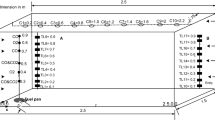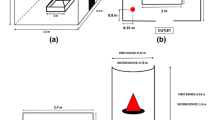Abstract
This paper is an attempt to integrate theoretical Computational Fluid Dynamics (CFD) calculations with practical fire-fighting tactics commonly used when arriving at the scene of an underventilated fire. The paper shows that CFD has a great potential in improving understanding and creating better effectiveness in the estimation of fire-fighting tactics. If burning has occurred in a lack of oxygen for a long time, excessive pyrolysis products may have accumulated in the fire compartment. If air is suddenly introduced in the compartment a backdraft may occur. The CFD code used for the simulations is fire dynamics simulator (FDS). In this paper, we focus on the conditions that can lead to backdraft, and not the deflagration or rapid combustion in itself. Therefore, the simulations focus on the gravity current and the mixing process between cold fresh air and hot smoke gases by considering a uniform temperature inside the building as initial condition. The different tactics studied include natural ventilation, positive pressure ventilation (PPV) and dilution by water mist. Their effectiveness is observed comparing them with a reference scenario, where no action is taken. The main objective of natural ventilation is to find the fire source, and the venting is more effective with several openings. Tactics involving PPV are very effective in evacuating the unburnt gases, but increases the mixing, and consequently the probability of backdraft during the early stage of operation. On the other hand, the addition of water mist can reduce the danger of backdraft by reducing the concentration of unreacted combustible gases below the critical fuel volume fraction (CFVF), where ignition cannot occur. If the dilution level is insufficient the danger of backdraft is increased, mainly because the process of gases evacuation is longer due to cooling, which reduces the density difference between hot and cold gases. During a fire-fighting operation, the choice of tactic depends mainly on whether there are people left in the building or not, but also on the fire-fighters’ knowledge of the building’s geometry and the fire conditions. If the situation shows signs of strongly underventilated conditions, the danger of backdraft has to be considered and the most appropriate mitigation tactics must be applied.

















Similar content being viewed by others
Abbreviations
- Cair :
-
The heat capacity of air (approximately 1 kJ/(kg K))
- CFVF:
-
Critical fuel volume fraction
- CMC:
-
Critical mixture composition
- D(X):
-
Dilution level, corresponds to a scenario with X % mass concentration
- GML:
-
Gas measurements line
- LFL:
-
Lower flammability limit
- M o :
-
Initial mass of hot gases
- M vap :
-
Mass of vapor added to obtain the desired dilution
- \(M_{{{\text{CH}}_{4} }} \) :
-
Mass of unburnt gases (methane)
- Q fan :
-
Flow rate of the PPV fan
- t :
-
Simulation time
- T :
-
Temperature
- T final :
-
Temperature of hot gases after dilution
- T in :
-
Temperature of hot gases inside the compartment
- T out :
-
Temperature of cold gases outside the compartment (ambient)
- UFL:
-
Upper flammability limit
- v fan :
-
Velocity at the inflow boundary, due to PPV fan
- V gas :
-
Volume of hot gases in the enclosure
- V w :
-
Volume of water to cool the gases from T in to T final
- X :
-
Mass concentration of unburnt gases (methane)
- y :
-
Dilution factor (%)
- Z low :
-
Lower vertical limit of the flammability region
- Z up :
-
Lower vertical limit of the flammability region
- ΔH w :
-
Heat of vaporization for water (2260 kJ/kg)
- Δz :
-
Vertical width of the flammability region. Δz = Z up − Z low
- ρ gas :
-
Density of gases
- ρ in :
-
Density of hot gases inside the compartment (approximately 353/T in)
- ρ out :
-
Density of cold gases outside the compartment
- ρ w :
-
Water density in kg/L (1 kg/L)
- χ :
-
Dilution ratio
References
Weng WG, Fan WC (2002) Experimental study on the mitigation of backdraft in compartment fires with water mist. J Fire Sci 20(4):259–278
Fleischmann M, McGrattan KB (1999) Numerical and experimental gravity currents related to backdrafts. Fire Safety J 33:21–34
Fleischmann CM (1993) Backdraft phenomena. University of California, Berkley
Gojkovic D (2001) Initial backdraft experiments. Report 3121, Department of Fire Safety Engineering, Lund University, Sweden
Gottuk DT, Peatross MJ, Farley JP, Williams FW (1999) The development and mitigation of backdraft: a real-scale shipboard study. Fire Safety J 33:261–282
Fahy RF, LeBlanc PR (2006) Fire-fighters fatalities in the United States—2005. Fire analysis and research division, National Fire Protection Association
Bengtsson LG, Karlsson B (2000) An experimental and statistical study of the phenomena flashover, backdraft and smoke gas explosion 3rd international seminar on fire and explosion hazards, 10–14 April, 2000. The University of Central Lancashire, England
Chitty R (1994) A survey on backdraught. Fire Res Station, Pub No 5/94
Guigay G, Karlsson B, Elíasson J (2006) Numerical and analytical determination of combustion products in strongly underventilated fires prior to backdraft. Presented in workshop in enclosure fires, FIREsert
Elíasson J, Guigay G, Karlsson B (2008) Enclosure fires, gravity currents and the backdraft problem. J Fire Sci, JFS 092116, in press
Guigay G, Elíasson J, Horvat A, Sinai Y (February 2006) Semi-analytic and CFD calculation of gravity flows in backdraft studies. Intended for publication in J Fire Sci
Gojkovic D, Karlsson B (2000) Describing the importance of the mixing process in a backdraft situation using experimental work and CFD simulations 3rd international seminar on fire and explosion hazards, 10–14 April, 2000. The University of Central Lancashire, England
Bengtsson LG (2001) Enclosure fires: Swedish Rescue Services Agency
Svensson S (2002) A study of tactical patterns during fire fighting operations. Fire Safety J 37:673–695
Iceland Fire Authority (2006) Completion of the recommendations. Firenet project report
Kerber (2006) Evaluation of the ability of fire dynamic simulator to simulate positive pressure ventilation in the laboratory and practical scenarios. NIST report NISTIR 7315, April
Tuomisaari (1997) Smoke ventilation in operational fire fighting. VTT Publication 326
Positive pressure ventilation; PPV in firefighting (2006) http://www.firetactics.com/PPV.htm
FDS-fire dynamics simulator, NIST (2008) http://fire.nist.gov/fds/
Gojkovic D, Bengtsson LG (2001) Some theoretical and practical aspects on fire fighting tactics in a backdraft situation. Proceedings of the 9th conference, Interflam
SOFIE homepage (2005) http://www.cranfield.ac.uk/sme/sofie/
Drysdale D (1998) An introduction to fire dynamics, 2nd edn. Wiley
Beyler B (1995) Flammability limits of premixed and diffusion flames. In: Chapter 2–19 of SFPE handbook of fire protection engineering, 2nd edn. NFPA Publication
Acknowledgements
The present work was performed as a part of the project “Under-Ventilated Compartments Fires (FIRENET)” (Co. No. HPRN-CT-2002-00197). The project is supported by the EU Research Training Network FP5, which is gratefully acknowledged.
Author information
Authors and Affiliations
Corresponding author
Rights and permissions
About this article
Cite this article
Guigay, G., Gojkovic, D., Bengtsson, LG. et al. The Use of CFD Calculations to Evaluate Fire-Fighting Tactics in a Possible Backdraft Situation. Fire Technol 45, 287–311 (2009). https://doi.org/10.1007/s10694-008-0058-4
Received:
Accepted:
Published:
Issue Date:
DOI: https://doi.org/10.1007/s10694-008-0058-4




